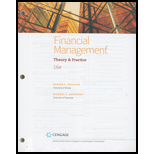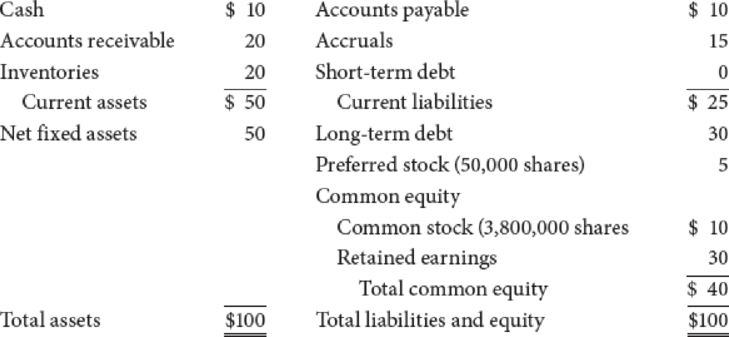
The following table gives the current
Travellers Inn (Millions of Dollars)

The following facts also apply to TII.
- (1) The long-term debt consists of 29,412 bonds, each having a 20-year maturity, semiannual payments, a coupon rate of 7.6%, and a face value of $1,000. Currently, these bonds provide investors with a yield to maturity of 11.8%. If new bonds were sold, they would have an 11.8% yield to maturity.
- (2) TII’s perpetual
preferred stock has a $100 par value, pays a quarterly dividend per share of $2, and has a yield to investors of 10%. New perpetual preferred stock would have to provide the same yield to investors, and the company would incur a 3.85% flotation cost to sell it. - (3) The company has 3.8 million shares of common stock outstanding, a price per share = P0 = $20, dividend per share = D0 = $1, and earnings per share = EPS0 = $5. The
return on equity (ROE) is expected to be 10%. - (4) The stock has a beta of 1.6%. The T-bond rate is 6%, and RPM is estimated to be 5%.
- (5) TII’s financial vice president recently polled some pension fund investment managers who hold TII’s securities regarding what minimum
rate of return on TII’s common would make them willing to buy the common rather than TII bonds, given that the bonds yielded 11.8%. The responses suggested a risk premium over TII bonds of 3 percentage points. - (6) TII is in the 25% federal-plus-state tax bracket.
Assume that you were recently hired by TII as a financial analyst and that your boss, the treasurer, has asked you to estimate the company’s WACC under the assumption that no new equity will be issued. Your cost of capital should be appropriate for use in evaluating projects that are in the same risk class as the assets TII now operates. Based on your analysis, answer the following questions.
- a. What are the current market value weights for debt, preferred stock, and common stock? (Hint: Do your work in dollars, not millions of dollars. When you calculate the market values of debt and preferred stock, be sure to round the market price per bond and the market price per share of preferred to the nearest penny.)
- b. What is the after-tax cost of debt?
- c. What is the cost of preferred stock?
- d. What is the required return on common stock using
CAPM ? - e. Use the retention growth equation to estimate the expected growth rate. Then use the expected growth rate and the dividend growth model to estimate the required return on common stock.
- f. What is the required return on common stock using the own-bond-yield-plus-judgmental-risk-premium approach?
- g. Use the required return on stock from the CAPM model, and calculate the WACC.
a.
To determine: The market value weights of debt, common stock and preferred stock.
Answer to Problem 17P
The market value weights of debt are 20%, common stock is 76% and preferred stock is 4%.
Explanation of Solution
Determine the market value weights of debt, common stock and preferred stock
Excel Spreadsheet:

Excel Workings:

Therefore, the market value weights of debt are 20%, common stock is 76% and preferred stock is 4%.
b.
To determine: The after-tax cost of debt.
Answer to Problem 17P
The after-tax cost of debt is 8.85%.
Explanation of Solution
Determine the after-tax cost of debt
Therefore, the after-tax cost of debt is 8.85%.
c.
To determine: The cost of preferred stock.
Answer to Problem 17P
The cost of preferred stock is 10.40%.
Explanation of Solution
Determine the cost of preferred stock
Therefore, the cost of preferred stock is 10.40%.
d.
To determine: The required return on common stock using CAPM.
Answer to Problem 17P
The required return on common stock using CAPM is 14%.
Explanation of Solution
Determine the required return on common stock using CAPM
Therefore, the required return on common stock using CAPM is 14%.
e.
To determine: The required return on common stock using dividend growth model.
Answer to Problem 17P
The required return on common stock using dividend growth model is 13.40%.
Explanation of Solution
Determine the payout ratio
Therefore, the payout ratio is 20%.
Determine the growth rate
Therefore, the growth rate is 8%.
Determine the required return on common stock using dividend growth model
Therefore, the required return on common stock using dividend growth model is 13.40%.
f.
To determine: The required return on common stock using own-bond-yield-plus-judgmental- risk-premium approach.
Answer to Problem 17P
The required return on common stock using own-bond-yield-plus-judgmental- risk-premium approach is 14.80%.
Explanation of Solution
Determine the required return on common stock using own-bond-yield-plus-judgmental- risk-premium approach
Therefore, the required return on common stock using own-bond-yield-plus-judgmental- risk-premium approach is 14.80%.
g.
To determine: The WACC.
Answer to Problem 17P
The WACC is 12.83%.
Explanation of Solution
Determine the WACC
Therefore, the WACC is 12.83%.
Want to see more full solutions like this?
Chapter 9 Solutions
FINANCIAL MANAGEMENT(LL)-TEXT
- Scenario three: If a portfolio has a positive investment in every asset, can the expected return on a portfolio be greater than that of every asset in the portfolio? Can it be less than that of every asset in the portfolio? If you answer yes to one of both of these questions, explain and give an example for your answer(s). Please Provide a Referencearrow_forwardHello expert Give the answer please general accountingarrow_forwardScenario 2: The homepage for Coca-Cola Company can be found at coca-cola.com Links to an external site.. Locate the most recent annual report, which contains a balance sheet for the company. What is the book value of equity for Coca-Cola? The market value of a company is (# of shares of stock outstanding multiplied by the price per share). This information can be found at www.finance.yahoo.com Links to an external site., using the ticker symbol for Coca-Cola (KO). What is the market value of equity? Which number is more relevant to shareholders – the book value of equity or the market value of equity?arrow_forward
- FILE HOME INSERT Calibri Paste Clipboard BIU Font A1 1 2 34 сл 5 6 Calculating interest rates - Excel PAGE LAYOUT FORMULAS DATA 11 Α΄ Α΄ % × fx A B C 4 17 REVIEW VIEW Alignment Number Conditional Format as Cell Cells Formatting Table Styles▾ Styles D E F G H Solve for the unknown interest rate in each of the following: Complete the following analysis. Do not hard code values in your calculations. All answers should be positive. 7 8 Present value Years Interest rate 9 10 11 SA SASA A $ 181 4 $ 335 18 $ 48,000 19 $ 40,353 25 12 13 14 15 16 $ SA SA SA A $ Future value 297 1,080 $ 185,382 $ 531,618arrow_forwardB B Canning Machine 2 Monster Beverage is considering purchasing a new canning machine. This machine costs $3,500,000 up front. Required return = 12.0% Year Cash Flow 0 $-3,500,000 1 $1,000,000 2 $1,200,000 3 $1,300,000 4 $900,000 What is the value of Year 3 cash flow discounted to the present? 5 $1,000,000 Enter a response then click Submit below $ 0 Submitarrow_forwardFinances Income Statement Balance Sheet Finances Income Statement Balance Sheet Materia Income Statement Balance Sheet FY23 FY24 FY23 FY24 FY23 FY24 Sales Cost of Goods Sold 11,306,000,000 5,088,000,000 13,206,000,000 Current Current Assets 5,943,000,000 Other Expenses 4,523,000,000 5,283,000,000 Cash 211,000,000 328,600,000 Liabilities Accounts Payable 621,000,000 532,000,000 Depreciation 905,000,000 1,058,000,000 Accounts 502,000,000 619,600,000 Notes Payable 376,000,000 440,000,000 Earnings Before Int. & Tax 790,000,000 922,000,000 Receivable Interest Expense 453,000,000 530,000,000 Total Current Inventory 41,000,000 99,800,000 997,000,000 972,000,000 Taxable Income 337,000,000 392,000,000 Liabilities Taxes (25%) 84,250,000 98,000,000 Total Current 754,000,000 1,048,000,000 Long-Term Debt 16,529,000,000 17,383,500,000 Net Income Dividends 252,750,000 294,000,000 Assets 0 0 Fixed Assets Add. to Retained Earnings 252,750,000 294,000,000 Net Plant & 20,038,000,000 21,722,000,000…arrow_forward
- Do you know what are Keith Gill's previous projects?arrow_forwardExplain why long-term bonds are subject to greater interest rate risk than short-term bonds with references or practical examples.arrow_forwardWhat does it mean when a bond is referred to as a convertible bond? Would a convertible bond be more or less attractive to a bond holder than a non-convertible bond? Explain in detail with examples or academic references.arrow_forward
- Alfa international paid $2.00 annual dividend on common stock and promises that the dividend will grow by 4% per year, if the stock’s market price for today is $20, what is required rate of return?arrow_forwardgive answer general accounting.arrow_forwardGive me answers in general financearrow_forward

 Financial Reporting, Financial Statement Analysis...FinanceISBN:9781285190907Author:James M. Wahlen, Stephen P. Baginski, Mark BradshawPublisher:Cengage Learning
Financial Reporting, Financial Statement Analysis...FinanceISBN:9781285190907Author:James M. Wahlen, Stephen P. Baginski, Mark BradshawPublisher:Cengage Learning Managerial Accounting: The Cornerstone of Busines...AccountingISBN:9781337115773Author:Maryanne M. Mowen, Don R. Hansen, Dan L. HeitgerPublisher:Cengage Learning
Managerial Accounting: The Cornerstone of Busines...AccountingISBN:9781337115773Author:Maryanne M. Mowen, Don R. Hansen, Dan L. HeitgerPublisher:Cengage Learning EBK CONTEMPORARY FINANCIAL MANAGEMENTFinanceISBN:9781337514835Author:MOYERPublisher:CENGAGE LEARNING - CONSIGNMENT
EBK CONTEMPORARY FINANCIAL MANAGEMENTFinanceISBN:9781337514835Author:MOYERPublisher:CENGAGE LEARNING - CONSIGNMENT




